MEMBER PRESS RELEASE - Renewable Natural Gas Facility Inaugurated in Iowa Avoiding 15,800 Tons of…
MEMBER PRESS RELEASE (Opinion piece) – Choosing heat exchangers for viscous wastes & sludges
MEMBER PRESS RELEASE (Opinion piece) – Choosing heat exchangers for viscous wastes & sludges
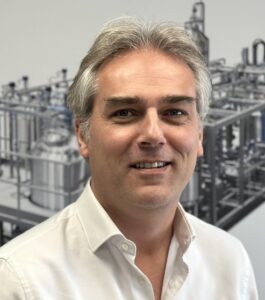
By Arnold Kleijn, Sales Director Europe, HRS Heat Exchangers
Heat exchangers are key components in many processes in the wastewater, anaerobic digestion and waste treatment sectors, including heating, pasteurisation and evaporation. They come in many forms, from the simplest plate heat exchangers to corrugated tube-in-tube and scraped surface designs. With so many differences in the composition of sludge, digestate, manure and wastewater streams, choosing the right heat exchanger for the right material and the right process is vital, not only to ensure effective processing and optimum product quality, but also to maximise operational and energy efficiency.
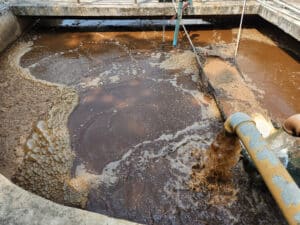
The high viscosity of most organic waste streams means that they require more energy to pump and move and often have a higher potential to foul pipework and heat exchangers, reducing heat transfer and operational efficiency.
What is meant by viscosity?
When considering different sorts of sludges, it is useful to clarify what we mean by viscosity. It is normally defined as a measure of a substance’s resistance to motion under an applied force, based on the amount of force required to remove one layer in relation to another (shear stress) and the change in speed of the layers relative to each other (the shear rate). It is measured in units called centipoise (cP) with one cP being equal to 1 mPa sec-1 (millipascal per second).
As you would expect, the viscosity of sludges and digestates increases as the solids content rises and also depends on temperature. As an example, a sewage sludge with 2% solids may have a viscosity of 5 cP, while a similar material with 10% solids can be 50 cP. The high variability of these materials means that example values are of little use, but liquid manures can be anywhere from 20 cP at 2.5% total solids (TS), up to 500 cP at 12% TS.
However, the viscosity of different materials can change as they are subjected to different levels of sheer stress and temperature. Because of this, most fluids are classified as being either Newtonian, or non-Newtonian. Newtonian fluids have the same viscosity irrespective of changes in temperature or shear stress – the most common example of this is water. Non-Newtonian fluids (which can then be sub-divided into five different categories) have viscosities which fluctuate depending on the shear rate applied.
In practice, this means that when dealing with non-Newtonian products (such as some sludges and slurries), elements of the processing operation – including pumping, heating, cooling and passing through pipework – all have the potential to affect the waste stream’s viscosity and handling requirements.
Corrugated tube heat exchangers: design & selection
Choosing the correct type of heat exchanger, together with careful system design, helps avoid such problems. Corrugated tube heat exchangers, such as those designed and produced by HRS, ensure that viscous materials can be processed efficiently as the corrugated tube design helps minimise fouling, increasing thermal efficiency during operation, and extending operational periods between cleanings. In addition, corrugated tube heat exchangers have a lower pumping requirement than smooth tube heat exchangers due to their compact nature, which results in a lower pressure drop. This helps to increase operational life while reducing maintenance costs compared with other types of heat exchanger.
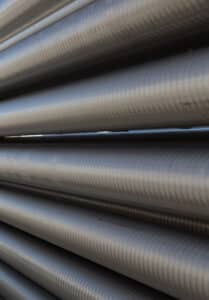
Where sludge has a relatively low viscosity but contains suspended solids a double-tube heat exchanger, like the HRS DTI Series, is likely to be suitable. In a double-tube heat exchanger, one large tube carries the product, so there is less chance of blockages and fouling by any particles contained in the sludge. In addition, the HRS DTIR Series has a design specifically adapted for energy recovery from low viscosity sludges and features a removeable inner tube to aid cleaning and inspection.
Scraped surface heat exchangers for the toughest challenges
For the most viscous materials, the use of corrugated tubes will not be sufficient to prevent fouling or maintain movement through the exchanger. In these cases, scraped surface heat exchangers (SSHEs) are ideal, particularly for evaporation.
In most applications, this will involve the HRS Unicus Series, which uses a reciprocating movement to mix the fluid whilst cleaning the heat exchange surface. The separate hydraulic action of the Unicus Series means that the speed of the scrapers makes it particularly suitable for handling and concentrating brines, manures, food waste and wastewater.
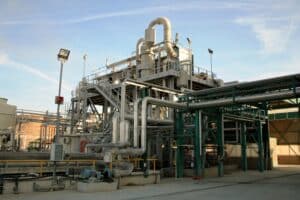
We also produce a special version of the Unicus Series for evaporation applications. During evaporation, fouling and reduced heat transfer can become a problem for traditional evaporators. With the Unicus, the scraping action keeps the heat transfer surface clean and maintains high heat transfer, allowing the Unicus Series to concentrate waste streams to concentrations that traditional technologies cannot match. This makes it ideal solution for the concentration of environmental waste where volume reduction is vital. Unicus evaporators can be applied in a multi-effect setup or in combination with mechanical vapour recompression. Concentration under vacuum can also be applied with a Unicus evaporator, while the scraped surface operation allows continuous operation and reduces downtime.
Dedicated systems for sludge and digestate concentration
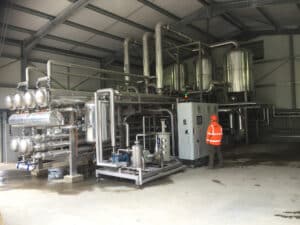
As well as the Unicus Series, the HRS Digestate Concentration System (DCS) is also available as a dedicated solution to remove up to 80% of the water content from digestate and sludge, producing a material containing 20% dry solids.
The DCS works by superheating the digestate in a vacuum to facilitate concentration, using evaporation to significantly reduce digestate volumes while, at the same time, increasing the nutrient content. The first part of the process involves heating the liquid digestate in heat exchangers; no additional water or energy is required, as the surplus water from the plant’s CHP engine (which is usually available at 85˚C) is used as the heating media. The digestate is then pumped into a cyclone separator; the high-speed rotating airflow causes the solid particles (which are too heavy to follow the tight curve of the airstream) to fall to the bottom of the cyclone, where they can be removed.
The steam produced from this first cycle (usually available at 70˚C) is then used as the heating media for the second effect, whereby the process is repeated. The subsequent steam (usually available at 60˚C) is used as the heating media for the third cycle – the number of effects is determined by the level of dry solids required, and the amount of spare heat available, up to a maximum of four cycles. After the final effect, the steam is condensed back into water and can then be used to dilute feedstock going into the front end of the digester; a completely closed loop system. When linked to an on-site CHP plant, the DCS is wholly self-sufficient – no energy or water is brought in or wasted, and everything is re-used.
For more information, please contact your local representative or our environmental systems specialists today. www.hrs-heatexchangers.com
-ENDS-
Notes to editors
About HRS Heat Exchangers
Located in the UK, HRS Heat Exchangers is part of the EIL Group (Exchanger Industries Limited) which operates at the forefront of thermal technology. HRS offers innovative heat transfer solutions worldwide across a diverse range of industries. With more than 40 years’ experience in the wastewater treatment, anaerobic digestion and environmental sectors, specialising in the design and manufacture of an extensive range of turnkey systems and components,incorporating our corrugated tubular and scraped surface heat exchanger technology, HRS products are compliant with global design and industry standards. HRS has a network of offices throughout the world: Australia, Canada, New Zealand, UK, Spain, USA, Malaysia and India; with manufacturing plants in India, Spain and Canada.
Email for publication:
info@uk.hrs-he.com
For UK media enquiries about HRS Heat Exchangers please contact
FastLoop Media:
marketing@hrs-he.com
Bev Small, FastLoop Media
T +44 (0) 7901 841491 E bev@fastloopmedia.com
Kate O’Reilly, FastLoop Media
T +44 (0)7894 039 609 E kate@fastloopmedia.com
